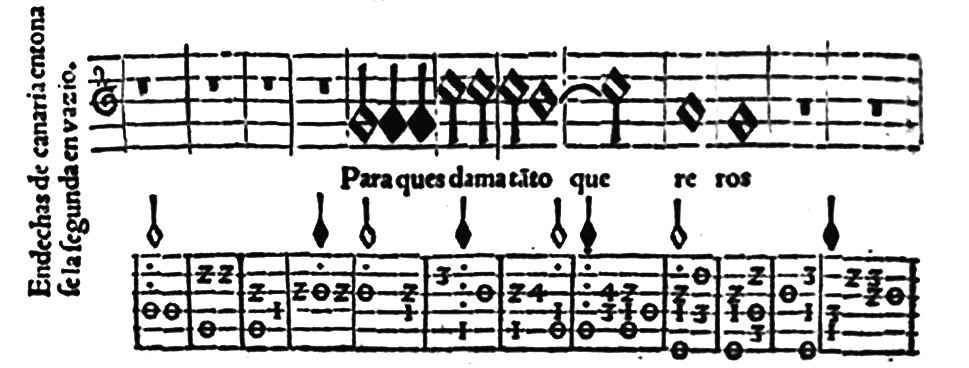Diego Pisador
Para qué es dama tanto quereros endechas de Canarias
Libro de música para vihuela (1552), fol. 6v
pi010
| Source title | Endechas de canaria entonase la segunda en vazio. |
|---|---|
| Title in contents | Endechas de canaria, paraque es dama tamto quereros, las tres bozes tañidas y la otra cantada por defuera. |
| Text incipit | Para ques dama ta[n]to quereros |

Music
Category intabulation
Genre endechas
Fantasia type
Mode 3
Voices 4
Length (compases) 62
Vihuela
Tuning A
Courses 6
Final IV/2
Highest I/7
Lowest VI/3
Difficulty not specified
Tempo not specified
Song Text
Language ES
Vocal notation staff notation texted
Commentary
A setting of the text “¿Para qué es dama tanto quereros?’ a setting of the genre known as “endechas” or “endechas de Canarias”, a form of lament. It is not clarified whether this piece is an arrangement of a polyphonic setting or an original work by Pisador. The former seems more likely. It is based on the theme of the endechas canarias as transmitted in numerous sources. This piece is analysed by L. Siemens (siemens1975) and the text is edited in Frenk, Nuevo corpus (frenk2003), no 800, and by Cejador y Frauca (cejador1921, vol 3, no 189).Juan Bermudo (berm1555, fol. 83) gives an example of the endechas canarias with the same melody, some rhythmic variants, and different polyphonic setting. Transcribed in Stevenson Juan Bermudo (stevenson1960-1, 83-84). Bermudo’s text gives two strophes and the beginning of a third that seems to be the same text that Pisador gives:
1. Aunque me veys en tierra agena, / Allá en Canaria tengo una prenda,/ No la olvidaré hasta que muera.
2. Si quando viene el pesar durasse, / No havría mármol que no quebrasse, / ¡Qué me hará el coraçón de carne!
3. Para que es da...
This might indicate that the Pisador text and Bermudo’s stanza 3 was well known.
Fuenllana, fol. 169v [fu178] sets a different text. The melody is the same as Pisador and Bermudo.
Text: Si los delfines mueren de amores / Triste de mí, qué harán los hombres / Que tienen tiernos los coraçones.
Another three-voice setting of the same text by Pere Vila [vila1561, p. 62 -only the altus survives]. Pedrell [pedrellCATA, vol. 2, p. 172] reproduces the text. Othervariants of the same text are in the Cancionero de la Sablonara (no 25) and Concionero de Evora “Ahum que me véais en tierra agena”
The “tierra agena” theme of the related versions is also found in other works including Daza “A tierras agenas”, Uppsala “Ay de mí que en tierra ajena” (villancico a 3), and Peñalosa “A tierras ajenas” in CMP.

Editions
Recordings
Song Text
¿Para qué es dama, tanto quereros?
Para perderme y a vos perderos:
más valiera nunca veros.
• continuation [from other sources]:
Aunque me veis en tierra ajena
allá en Canaria tengo una prenda:
no la olvidaré hasta que muera.
Si quando viene el pesar durasse
no habría mármol que no quebrasse
¡qué me hará el coraçón de carne!
Si los delfines mueren de amores,
triste de mí, ¿qué harán los hombres,
que tienen tiernos los coraçones?